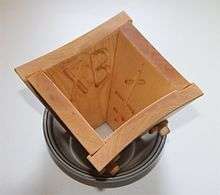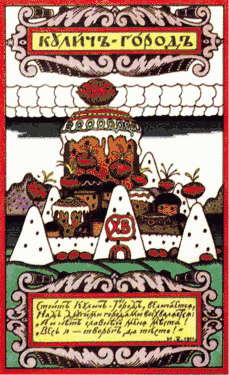Paskha

Paskha (also spelled pascha, or pasha; Russian: па́сха; [ˈpasxə]; "Easter") is a festive dish made in Eastern Orthodox countries which consists of food that is forbidden during the fast of Great Lent. It is made during Holy Week and then brought to Church on Great Saturday to be blessed after the Paschal Vigil. The name of the dish comes from Pascha, the Eastern Orthodox celebration of Easter.
Cheese paskha is a traditional Easter dish made from quark (curd cheese, Russian: творог, tr. tvorog), which is white, symbolizing the purity of Christ, the Paschal Lamb, and the joy of the Resurrection. It is formed in a mould, traditionally in the shape of a truncated pyramid (a symbol of the Church; this form is also said to represent the Tomb of Christ).[1] It is usually served as an accompaniment to a rich Easter bread called paska in Ukrainian and kulich in Russian.[2]
The pascha is decorated with traditional religious symbols, such as the "Chi Ro" motif, a three-bar cross, and the letters X and B (Cyrillic letters which stands for Христосъ Воскресе. This is the Slavonic form of the traditional Paschal greeting: "Christ is Risen!"). All of these religious decorations symbolize Christ's Passion and Resurrection.
Preparation

In addition to the main ingredient (tvorog), additional ingredients, such as butter, eggs, smetana (sour cream), raisin, almonds, vanilla, spices, and candied fruits can be used.
The paskha can either be cooked or uncooked (raw). Cooked paskha is made in the form of an egg custard, to which the remaining ingredients are folded in. An uncooked paskha is made simply of the raw curd and the other ingredients mixed at room temperature. Since uncooked curd cannot be conserved for a long period of time, these paskhas are typically made smaller.
The tvorog is first pressed in order to eliminate the maximum amount of liquid possible, then put twice through a sieve to make a homogenous mass. If the paskha is cooked, this mass is then heated. The pan containing the mixture is then placed in a container of cold water and progressively cooled. Afterwards it is placed in a tradional wooden mould assembly called pasochnitsa (пасочница), with a layer of cheese cloth protecting the mould. The wooden mould can be taken apart for cleaning; however, more modern materials, such as plastics, are used nowadays. The mould is cooled for twelve hours in a cold, but not freezing place (typically in a cellar or refrigerator). Finally, the paskha is turned out of the mould, the cheesecloth removed, and put on a dish. It may then be decorated with candied fruits, nuts, or flowers. In contemporary times, cheese paska is not always formed in a mould and is sometimes served in a mound on a plate.
The paskha (or at least a portion of it) will be placed in an Easter basket together with other festal foods, and taken to church to be blessed.
Cultural references

An 18th-century church in St. Petersburg is known as "Kulich and Paskha", because the rotunda of the church resembles kulich, while the adjacent belfry has a pyramidal form reminiscent of paskha.[3]
 Boris Kustodiev's Easter Greetings (1912) shows traditional Russian khristosovanie (exchanging a triple kiss of peace), with such foods as Easter eggs, kulich and a white, triangular cheese paskha in the background
Boris Kustodiev's Easter Greetings (1912) shows traditional Russian khristosovanie (exchanging a triple kiss of peace), with such foods as Easter eggs, kulich and a white, triangular cheese paskha in the background Postcard design by Ivan Bilibin displaying cheese paskhas around kulich. "Kulich-city is standing, glorifying itself; Lauding itself over other cities; There is no other place better than me!; For I am all quark and dough!"
Postcard design by Ivan Bilibin displaying cheese paskhas around kulich. "Kulich-city is standing, glorifying itself; Lauding itself over other cities; There is no other place better than me!; For I am all quark and dough!"
See also
- List of Russian dishes
-
 Food portal
Food portal
References
- ↑ Easter Molded Cheese Dessert Recipe - Paska / Paskha by Barbara Rolek About.com
- ↑ Easter recipes: Kulich & Paskha April 4, 2007 Orthodoxy and the World
- ↑ [http://www.enlight.ru/camera/110/index_e.html
External links
| Wikimedia Commons has media related to Paskha (dish). |
- Paskha recipe
- Various paskha recipes (in Russian)
- Collins Dictionary